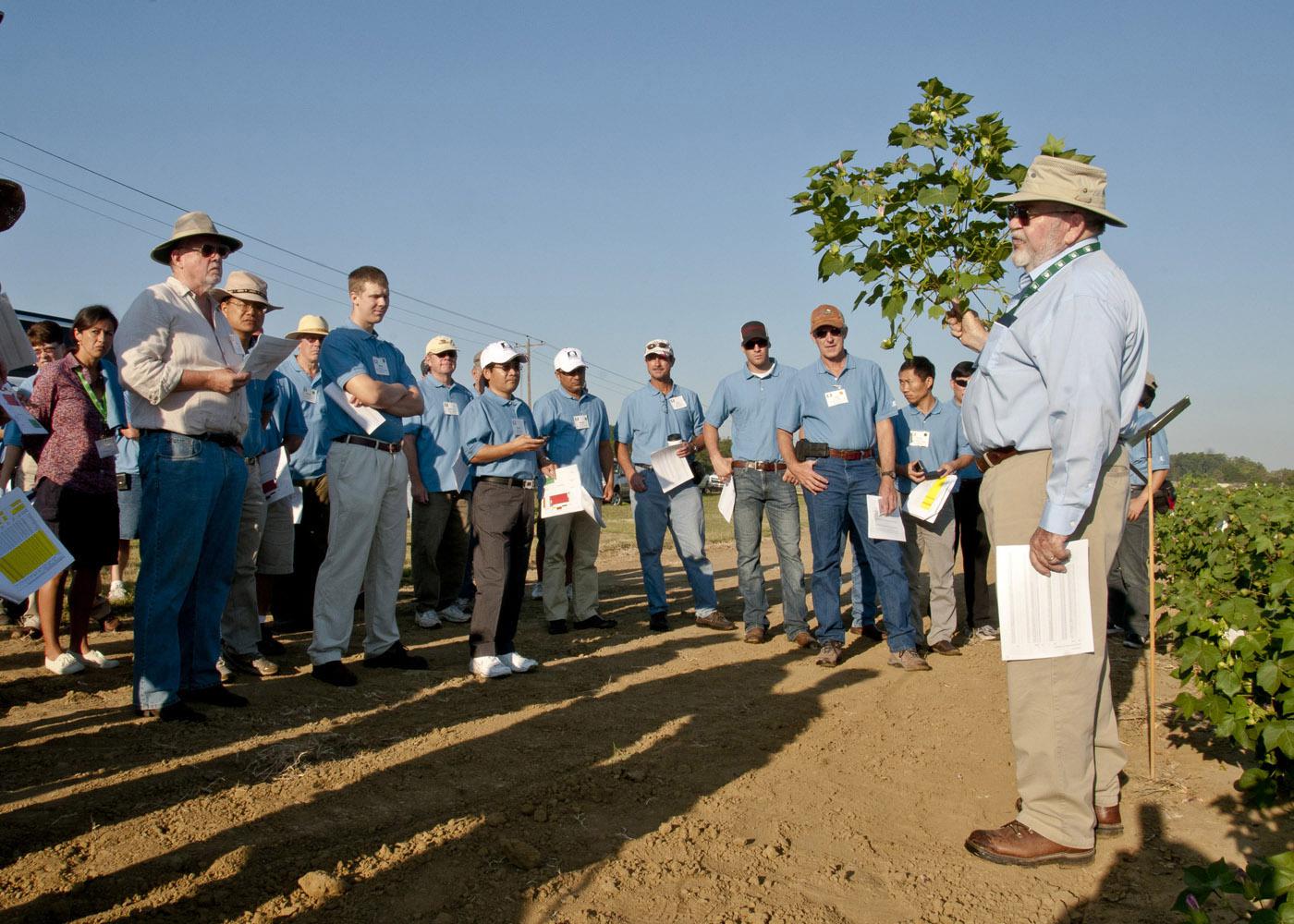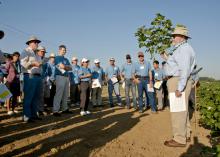Information Possibly Outdated
The information presented on this page was originally released on September 1, 2011. It may not be outdated, but please search our site for more current information. If you plan to quote or reference this information in a publication, please check with the Extension specialist or author before proceeding.
World's cotton breeders tour MSU research plots
MISSISSIPPI STATE – More than 120 cotton breeders from around the world spent Tuesday examining cotton research being conducted at two Mississippi State University facilities.
The group was part of the four-day Cotton Breeders’ Tour. The scientists visited university and industry locations in Arkansas, Mississippi and Louisiana on this year’s trip. Tours are sponsored by Cotton Inc., and are held every other year, rotating through each of the nation’s five cotton-growing regions.
Jack McCarty, a research agronomist with the U.S. Department of Agriculture working at MSU, helped coordinate the Mississippi stops. Visitors toured Mississippi Agricultural and Forestry Experiment Station and USDA research plots at MSU’s R.R. Foil Plant Science Research Center in Starkville, and the Delta Research and Extension Center in Stoneville.
“We showed them some of our cotton breeding lines and our cotton breeding research,” McCarty said. “This tour is set up to facilitate interaction and exchange between public and private cotton breeders, and we rotate through the various regions to see what work is being done in other places.”
This year’s tour included participants from all the major U.S. cotton-producing states and from countries as far away as China and Australia. Participants were fairly equally divided between university and private industry researchers and breeders.
Greg Bohach, vice president of MSU’s Division of Agriculture, Forestry and Veterinary Medicine, said the university appropriates about $6 million annually to cotton research at MSU. This money is in addition to USDA funding and grants the university receives for this work.
“I’m in favor of partnerships and cooperation, and this is what you are here for on this tour,” Bohach said to the group.
The stops in Mississippi highlighted the work being done with reniform nematode resistance and chromosome substitution breeding lines.
David Weaver, an Auburn University professor in the agronomy and soils department, said Stoneville is probably the nation’s most important cotton research facility, and the opportunity to see MSU and USDA research there was a big draw for this year’s tour.
“We have the opportunity to see research that we may not have even known about before,” Weaver said.
MSU is one of 10 sites nationwide in the Regional Breeding Testing Network, which is a trial designed to provide public cotton breeders easy access to multi-environment testing of advanced breeding lines. The program is coordinated by Ted Wallace, MAFES cotton breeder. These test plots are located in Stoneville and Starkville.
Rachel Sharpe, a research associate in Auburn University’s agronomy and soils department, was glad to be able to see how the tested varieties were performing under control conditions and exposed to a tobacco budworm infestation.
“You get valuable information this way,” Sharpe said. “I like these tours because you get to see what other researchers are doing on their stations and see how they conduct their research.”
Johnie Jenkins, a USDA researcher, has been involved with cotton breeding in Mississippi for 50 years. He helped organize the Mississippi tour stops and said the ideas shared by participants on the tour are what make it most valuable.
“It is beneficial for cotton breeders to see what other breeding programs look like,” Jenkins said. “It is very important for them to see how cotton varieties perform in various areas of the United States, because cotton varieties developed in one area are expected to perform well everywhere.”
Joe Guzman, a research specialist with Bayer CropScience, comes from drought-ridden Lubbock, Texas. Water there is scarce this year, and only the cotton receiving limited irrigation is surviving.
“This tour helps us see more potential in plants where there is more irrigation available,” Guzman said. “We can see better what happens when the right inputs can be added.”
Other stops on the Cotton Breeders’ Tour included the University of Arkansas’ Northeast Research and Extension Center in Keiser, Ark.; Monsanto/DPL in Scott, Miss.; Dow/PhytoGen Seed Company and Bayer CropScience in Leland, Miss.; Louisiana State University’s Northeast Research Station in St. Joseph, La.; and the USDA Southern Regional Research Center in New Orleans.





